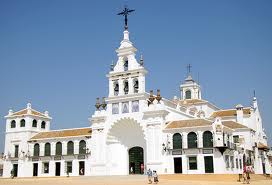The women were elegantly dressed in Flamenco dressed-each with a unique design-I do not believe I saw any two dresses the same. There hair was slicked back into the typical Spanish bun and on the very top-not side-but top of their head sat an rather enormous yet matching fake flower.
The men on the other hand were dressed like they were about to save a damsel in distress. They had on these wonderful old cowboy suits with a Spanish-type cowboy hat. Each guy had his own horse, like it represented masculinity or something because there were THOUSANDS of horses. One for each man, I guess.
There were no cars but everyone went around the little town from casa to case on horseback or by carriage which was-you guessed it-pulled by a horse. There was no pavement, rather, the streets were garnished in sand. Everywhere you went. Sand. Loads upon loads of sand. Once a horse road up to a casa, the cowboy tied his horse to one of the horse stands you see in the western movies. I believe my mouth was open the whole time because I do not believe my brain actually registered that I was in the year 2011. It felt as though I were in the middle of a movie, and like I mentioned, any moment expected Zoro to come riding by me with that sexy black cape of his. He didn't; however, I was not too sound, rather entertained. Greatly.
The fiesta in Rocia was not just to dress up like cowboys and flamenco dancers. It is actually a very old tradition that dates back many, many years. According to don Quijote the tradition goes something like this..
"Bridle those oxen and tie some flowers on your cart--it's time to make a dusty pilgrimage to the Andalusian countryside for Spain's biggest festival--the Romeria Del Rocio. Up to one million people are expected to travel to the marshes near the mouth of the Guadalquivir River to sing, eat, dance and pay homage to the Virgen del Rocio.
And while the religious fanaticism will be kicked into overdrive for the next few days, the Romerio is also a chance have some serious Spanish fun. Many of the participants are city-dwellers from Seville, Madrid and Barcelona who have come to spend time with nature and to get in touch with their roots.
The Virgen Del Rocio has been celebrated at this isolated site for over 800 years, and since 1758 the Romeria Del Rocio has been celebrated at Whitsun , the fiftieth day after Easter Sunday. There are really two parts to this celebration, the festival in Almonte and the actual pilgrimage that starts several days before. As with many Spanish festivals, the Romeria is a blend of Catholic and local pagan beliefs.
The Virgen Del Rocio has been the patron saint of Almonte since the 15th century, when a hunter found a statue of the Virgin Mary in a tree trunk near the marshes. The devoted claim her intense powers can cure disease, infertility and mental disorders.
The pilgrimage is a pretty traditional affair. Hundreds of "brotherhoods" from the surrounding villages and towns organise the processions that all end up in Almonte. Travellers (or "romeros") come from all over Andalucia on foot, on horseback or by cart. No motorised vehicles are allowed. Most of these pilgrims wear traditional clothes, women in bright gypsy-inspired flamenco dresses and men in the unique wide-brimmed "bolero" hats and short-cropped jackets associated with Andalusia. As they get closer to Almonte, the pilgrims camp out in the fields and forests of the surrounding Donana National Park.
All the romeros arrive in the village of Almonte just before dawn, and then the festivities really kick into gear. Accompanied by tambourines, flutes and guitars, the entire group strolls across the broad plains to the El Rocio shrine in the nearby marshes. Almonte's elite "Hermandad Matriz" brotherhood carries along a large silver shrine that contains an effigy of the Virgen. The sound of firecrackers fills the air as the crowds cry "Viva la Reina de la Marisma" ("Long live the Queen of the Marshes"). Once everyone arrives at the shrine, mass is recited and the Virgen is paraded around the dusty fields for several more hours.
For the next couple of days, the scene at El Rocio resembles a makeshift camp-out, a carnival, and a family reunion all at the same time. The crowds sing traditional songs and dance together in the fields. Snacks of tortilla, jamon, prawns and fried peppers are sold along with plenty of local wine and sherry. First-time pilgrims "baptise" themselves by dipping their hats in water and dousing themselves. In a day or so, the crowds will disperse and the fields of El Rocio will become quiet again."
Now if you still cannot fathom the idea of hundreds if not thousands of Spaniards riding around on horses dressed up in costumes, I have what lawyers like to call evidence for you. Visual evidence. These photos were not taken by me but are from the web; however, they match the festival I was at to a T.
The line of wagons making there way to Rocio. Every city has a different day that the people leave to go on pilgrimage and a different day that they return on.
Every man has a horse-and a girl.
Much of the fiesta--basically all--was centered around family, food, drinking, dancing and singing.
More pictures of the women's outfits.
The beautiful church in Rocio.
Like I said right out of a movie. Where have all the cowboys gone?
The Spanish John Wayne. YeeeHawww.
Modern meets traditional--don't worry ladies it will be in the states in 2 years!









No comments:
Post a Comment